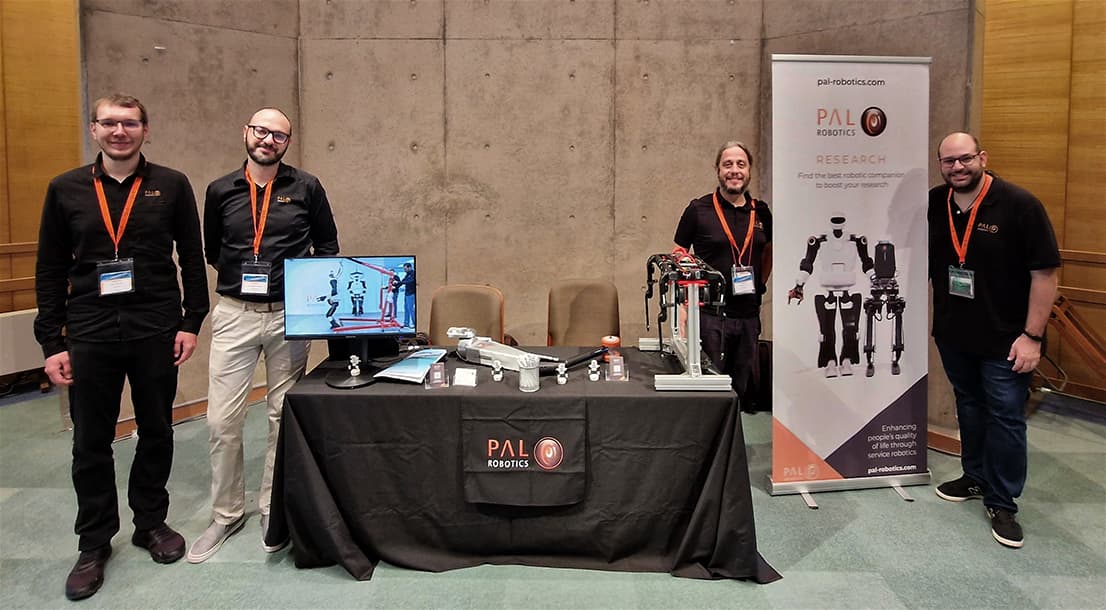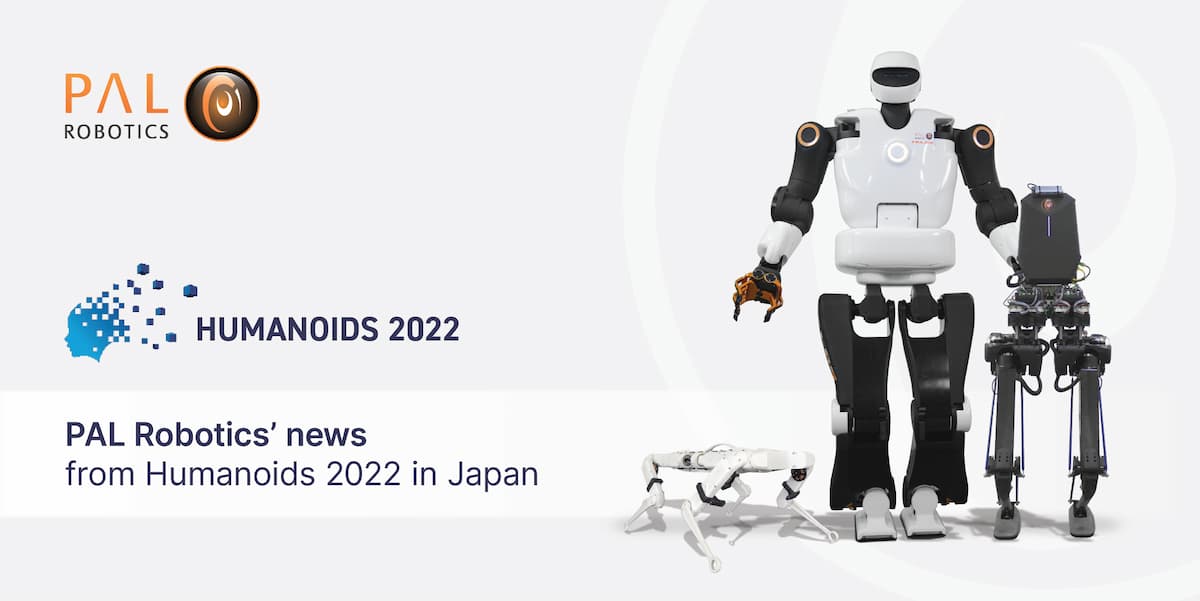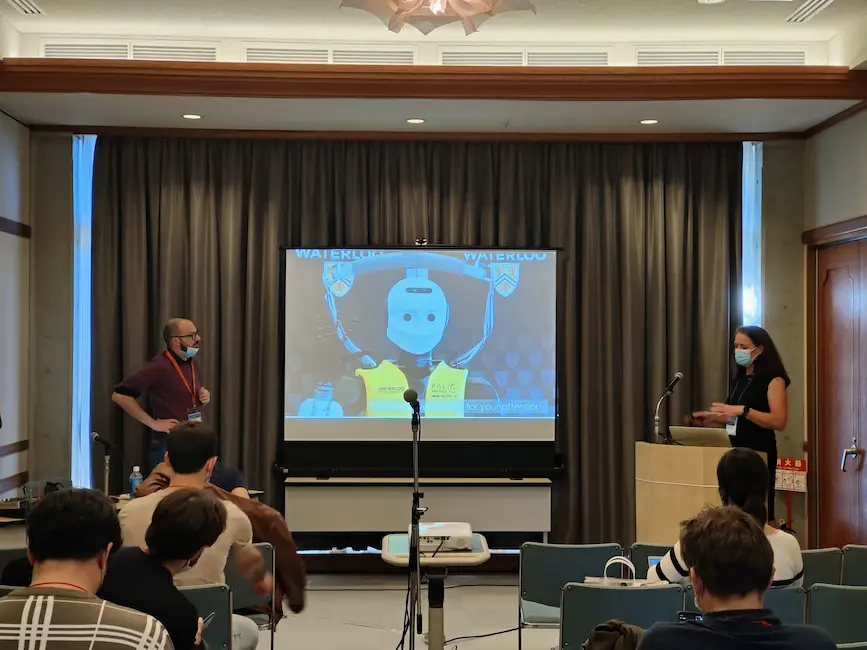PAL Robotics at Humanoids 2022
Last week we were delighted to participate in The IEEE-RAS International Conference on Humanoid Robots (Humanoids) as Silver Sponsors. We took part in four workshops, and we also presented the legged system of our Kangaroo robot which is in development, and the quadruped robot SOLO12 to visitors at our booth. We were fortunate to have the chance to participate in this internationally recognized prime event of the humanoid robotics community. Read on to find out more about the conference in Japan!
The IEEE-RAS International Conference on Humanoid Robots was established in 2000 and is held annually. The Humanoids Conference is a forum for researchers working in the area of humanoid robots including mechatronics, control, perception, planning, learning, human-robot interaction, biomechanics, artificial intelligence, cognition, and neuroscience.
PAL Robotics has previously taken part in Humanoids Conferences around the world, including in Toronto, Beijing, Seoul, and Madrid.

Workshops on topics including agile humanoid robots locomotion, development and design and Trajectory Optimization
We took part in the workshops “Can We Build Baymax?,” “Development and Design Pipelines – from First Ideas to Well-Functioning Robots”, “Agile Humanoid Locomotion: from Animation Characters to Real Robots,” and “Advancements in Trajectory Optimization and Model Predictive Control for Legged Systems.”
Read more about each of these workshops:
Workshop “Can We Build Baymax?”
PAL Robotics’ CEO, Francesco Ferro talked at the workshop “Can We Build Baymax?” which brought together researchers looking into education and open source using and enabling humanoid robots. Francesco talked about the latest developments at PAL Robotics in hardware and software, including open-source, tutorials available and ROS4HRI.
This workshop has been running since 2015, based on Baymax, the humanoid character in the Disney feature animation “Big Hero 6” – a healthcare robot with an inflatable body capable of interacting with people.
The workshop included the topics: tools for humanoid robots education, robots in exhibitions, museums, and other public places, robots in education (as teachers), open source software for humanoid robotics, and others.
Speakers at the workshop were:
- Chris Atkeson and Conrad Tucker, Carnegie Mellon University (CMU)
- Olivier Stasse, Laboratory for Analysis and Architecture of Systems (LAAS-CNRS)
- Jean Oh, Carnegie Mellon University (CMU)
- Akihiko Yamaguchi, Tohoku University
- Van Ho, Japan Advanced Institute of Science and Technology (JAIST)
- Francesco Ferro, PAL Robotics
- Alex Alspach, Toyota Research Institute (TRI)
- Bram Vanderborght, Vrije Universiteit Brussel (VUB)
- Matthieu Lapeyre, Pollen Robotics
- Sven Behnke, University of Bonn.
The workshop was organised by: Chris Atkeson (Carnegie Mellon University), Joohyung Kim (University of Illinois Urbana-Champaign), Jinoh Lee (German Aerospace Center (DLR), Katsu Yamane (Path Robotics Inc), and Alex Alspach (Toyota Research Institute).
Workshop “Development and Design Pipelines – from First Ideas to Well-Functioning Robots”
Our colleague Pierre Fernbach participated in the workshop “Development and Design Pipelines – from First Ideas to Well-Functioning Robots” focusing on the design and control of our agile bipedal robot Kangaroo. Pierre talked about the motivation and inspiration beyond the platform, the design of the lower body, trajectory optimization and Whole Body Inverse Dynamics.
The design space associated with the development of a new robot is simply vast. Therefore, to create and build a humanoid robot, adequate development and design pipelines and principals are required. This workshop addressed this issue by bringing together an interested audience with several experienced speakers and presenters, who share their related insights and give an overview of the design pipelines they use (or have used) to successfully develop humanoid / legged robots or other highly complex machines.
The topics discussed included:
- Mechanical design, motion planning and controls for legged robots
- Co-Design / parallel engineering of mechatronics and controls
- Iterative design and optimization techniques applied to the development of new robots
- Software infrastructure / architecture facilitating the design of new robots.
Johannes Englsberger (DLR), Robert Schuller (DLR), Robert J. Griffin (IHMC), Jinoh Lee (DLR), and Florian Loeffl (DLR) were the organisers of this workshop.
Workshop “Agile Humanoid Locomotion: from Animation Characters to Real Robots”
Enrico Mingo Hoffman of PAL Robotics participated in the workshop on Agile Humanoid Locomotion organised by Majid Khadiv (MPI-IS) and Steve Heim (MIT). The main goal of this workshop was to foster ideas to help push agile, explosive, and expressive motions in humanoid robots.
Topics discussed included Learning Agile Locomotion for Bipedal Robots, Real-to-sim-to-real, Bridging the gap between human, virtual characters and robots, and Model Predictive Control for Agile Bipedal Locomotion.
The workshop aimed to answer questions such as – how do we design robots capable of parkour? How can we encode stylistic elements of agile motions into a cost function? And how do we design controllers that can ride the constraints of the hardware, without falling?
Speakers at the workshop were:
- Talia Y. Moore, U Michigan
- Janneke Schwaner, UC Irvine
- Ludovic Righetti, NYU
- Ye Zhao, Georgia tech
- Enrico Mingo Hoffman, PAL Robotics
- Olivier Stasse, LAAS-CNRS
- Robert Griffin, IHMC
- Jeremy Dao, OSU
- Zhaoming Xie, Stanford
- João Ramos, UIUC
Workshop “Advancements in Trajectory Optimization and Model Predictive Control for Legged Systems”
Our colleague Enrico Mingo Hoffman was one of the organisers of the workshop “Advancements in Trajectory Optimization and Model Predictive Control for Legged Systems” which discussed how TO and MPC approaches enable synthesising and stabilising dynamic motions for multi-limbed robots like our robot Kangaroo.
Trajectory Optimization (TO) and Model Predictive Control (MPC) are model-based optimization approaches, built upon Optimal Control theory, which are becoming increasingly popular in robotics. Thanks to these techniques, legged systems can autonomously perform disparate tasks, from agile locomotion in complex terrains to dexterous interaction with the surroundings.
However, it remains an open question how to employ TO and MPC on real-legged systems effectively. This workshop aimed to inform the humanoid robotics research community of recent findings and future directions in TO and MPC applied to legged systems.
Topics of interest for the workshop included:
- Real-hardware implementation of TO and MPC for dynamic tasks
- Whole-body loco-manipulation planning and control
- Automatic synthesis of highly dynamic and contact-rich motions.
The organisers of the workshop were Enrico Mingo Hoffman (PAL Robotics), Francesco Ruscelli (IIT-HHCM), Katja Mombaur (University of Waterloo), and Chengxu Zhou (University of Leeds).
PAL Robotics booth with SOLO12 and Kangaroo legged-system
At the event we had the chance to display the quadruped platform, SOLO12, and our biped robot, Kangaroo’s legged system to visitors at our booth.
Read more about the ongoing development of the Kangaroo jumping robot prototype in our Kangaroo blog post.
Watch demonstrations with Kangaroo in our videos:
PAL Robotics | Kangaroo – Kinematic Whole Body Control with joint impedance controller
PAL Robotics | Kangaroo – Kinematic Whole Body Control with joint position controller
PAL Robotics | Kangaroo – Exploration of the workspace of the lower body
PAL Robotics | Kangaroo – Kinematic Whole Body Control with position controller at each joint
Read more about SOLO12 in our blog and webpage:
Find the details of all of our humanoid robots for research here:
PAL Robotics’ humanoids robots
We would like to thank the organisers of Humanoids 2022 for what was once again a great event, in particular to General Chairs of the organising committee, Koh Hosoda (Osaka University) and Tomomichi Sugihara (OMRON). We look forward to joining Humanoids again in 2023!

